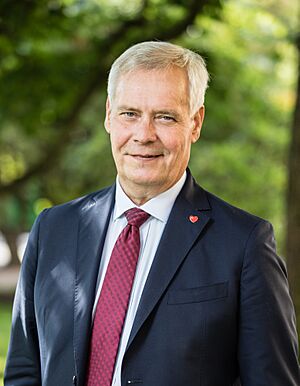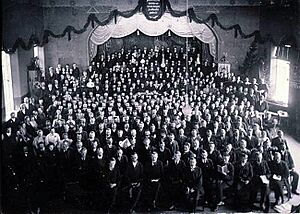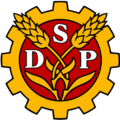Social Democratic Party of Finland facts for kids
Quick facts for kids <div style="padding-top:0.3em; padding-bottom:0.3em; border-top:2px solid Lua error in Module:European_and_national_party_data/config at line 227: attempt to index field 'data' (a nil value).; border-bottom:2px solid Lua error in Module:European_and_national_party_data/config at line 227: attempt to index field 'data' (a nil value).; line-height: 1;">
Social Democratic Party of Finland
|
|
|---|---|
 |
|
| Abbreviation | SDP Sd. |
| Chairperson | Antti Lindtman |
| Secretary | Mikkel Näkkäläjärvi |
| Parliamentary group leader | Tytti Tuppurainen |
| First deputy chair | Nasima Razmyar |
| Chair of the party council | Piia Elo |
| Founded | 20 July 1899 |
| Headquarters | Siltasaarenkatu 18–20C, 00530 Helsinki |
| Newspaper | Demokraatti |
| Think tank | Kalevi Sorsa Foundation |
| Student wing | Social Democratic Students |
| Youth wing | Social Democratic Youth |
| Women's wing | Social Democratic Women in Finland |
| Children's wing | Nuoret Kotkat |
| Swedish-speaking wing | Finlands Svenska Socialdemokrater |
| Membership (2021) | |
| Ideology | Social democracy Pro-Europeanism |
| Political position | Centre-left |
| European affiliation | Party of European Socialists |
| International affiliation | Progressive Alliance Socialist International |
| European Parliament group | Progressive Alliance of Socialists and Democrats |
| Nordic affiliation | SAMAK The Social Democratic Group |
| Union affiliate | Central Organisation of Finnish Trade Unions |
| Colours | Red |
| Anthem | Työväen marssi |
| Eduskunta | Lua error in Module:European_and_national_party_data/config at line 227: attempt to index field 'data' (a nil value). |
| European Parliament | Lua error in Module:European_and_national_party_data/config at line 227: attempt to index field 'data' (a nil value). |
| Municipalities |
1,699 / 8,586
|
| County seats |
321 / 1,379
|
| Website | |
| Lua error in Module:European_and_national_party_data/config at line 227: attempt to index field 'data' (a nil value). | |
The Social Democratic Party of Finland (SDP) is a major political party in Finland. It is often called demarit in Finnish. This party believes in social democracy, which means they support a fair society where everyone has equal chances and the government helps people.
The SDP is the oldest active political party in Finland, started in 1899. It works closely with trade unions, which are groups that protect workers' rights. The party is also part of bigger European and international political groups.
In December 2019, Sanna Marin became Finland's Prime Minister. She led a government with several other parties, and the SDP had many important roles. In September 2023, Antti Lindtman was chosen as the new leader of the party.
Contents
History of the SDP
The Social Democratic Party of Finland started in 1899. It was first called the Workers' Party of Finland. Their first big meeting was in Turku. In the early 1900s, the party pushed for important changes. They wanted better conditions for farmers, more jobs, and improved rights for workers. They also fought for freedom of speech and an 8-hour workday.
In 1903, the party changed its name to the Social Democratic Party of Finland. At the same time, they created the "Forssa Programme." This plan included goals like an 8-hour workday, a minimum wage, and education for everyone. It also called for a ban on alcohol, though this goal was later dropped.
The SDP was very connected to the Finnish Trade Union Federation. This meant that many union members were also part of the party. In 1906, when everyone in Finland got the right to vote, the SDP became very popular. In the 1916 election, they even won more than half the seats in the Finnish Parliament. This was the only time one party has had such a big majority in Finland's history.
After the Finnish Civil War in 1918, the party faced many challenges. Many of its leaders were lost. However, the party quickly rebuilt itself under Väinö Tanner. In 1918, some former SDP members started the Communist Party of Finland (SKP) in Moscow. For a long time, the working class in Finland was divided between supporting the SDP and the SKP.
The SDP, led by Väinö Tanner, worked hard to become a strong and respected party again. They became more focused on Finland's own interests. During World War II, the party played a key role in uniting the country against threats. After the war, the SDP focused on protecting Finland's independence and democracy. They sometimes received support from international groups to help them in their work.
In 1958, some members left the SDP to form a new group called the Social Democratic Union of Workers and Smallholders (TPSL). This happened because of disagreements about how the party should work and who it should cooperate with. However, the TPSL eventually faded, and most of its members returned to the SDP.
Since 1966, the SDP has been part of most Finnish governments. They often work with the Centre Party, but sometimes also with the National Coalition Party. From 1991 to 1995, the SDP was in the opposition, meaning they were not part of the government.
In the 1995 election, the SDP won a lot of support. Their leader, Paavo Lipponen, became Prime Minister and led the government for eight years. During this time, the party strongly supported Finland joining the European Union in 1995.
In the 2003 election, the SDP came in second place. Paavo Lipponen became the Speaker of Parliament. The SDP was part of the government again, but the Centre Party leader became Prime Minister.
In the 2007 election, the SDP came in third and went into opposition. They faced some tough elections in the following years. However, in the 2011 election, they became the second-largest party. They then joined a six-party government.
In 2014, Antti Rinne became the new leader of the SDP. In the 2015 election, the party lost some seats and became the fourth-largest party. They were in opposition again and often criticized the government's decisions.
In the 2019 election, the SDP became the largest party in Parliament. Antti Rinne became Prime Minister and formed a government with several other parties. However, he resigned in December 2019. Sanna Marin then took over as Prime Minister.
What the SDP Believes In
The SDP is a centre-left party that believes in social democracy. This means they want a society where everyone is treated fairly and has opportunities.
In their 2020 statement, the party listed its main goals:
- Sustainable development: Protecting the environment for the future.
- Equality: Making sure everyone has the same chances, no matter who they are.
- Peace and solidarity: Working together for a peaceful world.
- Freedom and cooperation: Allowing people to make their own choices and encouraging teamwork.
- A clean environment: Protecting nature.
- Democratic socialism: A system where people have a say in how society is run, and the government helps ensure fairness.
The SDP also supports the values of humanism and the achievements of the Nordic model, which is a way of organizing society common in Nordic countries, focusing on welfare and equality.
Historically, the party started by focusing on issues for workers and people without land. For a long time, it was the main political party for these groups in Finland.
The SDP used to prefer that Finland not join NATO, but instead work with the Partnership for Peace. However, this position changed after recent events in Europe.
The SDP supports:
- LGBT rights: Making sure all people, regardless of their sexual orientation or gender identity, have equal rights.
- Building nuclear power plants: To help produce energy.
- Keeping Swedish as one of Finland's two official languages.
- The separation of church and state: Meaning the government and religious institutions are separate.
- Increasing money for public schools and universities.
The party wants Finland to stop using coal for energy by 2030. They also support more work-based immigration to Finland. This is to help with the country's need for more workers and to address the low birth rate. The SDP believes it should be easier for people from outside the European Union to get work permits in Finland.
The SDP has a strong connection with trade unions. They have often opposed economic changes that would reduce benefits for unemployed people.
Who Votes for the SDP
The average age of someone who is a member of the SDP is about 61.5 years old. More than half of all people who vote for the SDP are actively working.
Party Organization
Symbols, Logos, and Posters
Party Leaders

| Time | Leader |
|---|---|
| 1899–1900 | Nils Robert af Ursin |
| 1900 | J. A. Salminen |
| 1900–1903 | K. F. Hellstén |
| 1903–1905 | Taavi Tainio |
| 1905–1906 | Emil Perttilä |
| 1906–1909 | Edvard Valpas-Hänninen |
| 1909–1911 | Matti Paasivuori |
| 1911–1913 | Otto Wille Kuusinen |
| 1913–1917 | Matti Paasivuori |
| 1917–1918 | Kullervo Manner |
| 1918–1926 | Väinö Tanner |
| 1926–1930 | Matti Paasivuori |
| 1930–1942 | Kaarlo Harvala |
| 1942–1944 | Väinö Salovaara |
| 1944–1946 | Onni Hiltunen |
| 1946–1957 | Emil Skog |
| 1957–1963 | Väinö Tanner |
| 1963–1975 | Rafael Paasio |
| 1975–1987 | Kalevi Sorsa |
| 1987–1991 | Pertti Paasio |
| 1991–1993 | Ulf Sundqvist |
| 1993–2005 | Paavo Lipponen |
| 2005–2008 | Eero Heinäluoma |
| 2008–2014 | Jutta Urpilainen |
| 2014–2020 | Antti Rinne |
| 2020–2023 | Sanna Marin |
| 2023–present | Antti Lindtman |
Important Members
| Oskari Tokoi | Led the Senate in 1917. |
| Väinö Tanner | Served as Prime Minister and Foreign Minister. |
| Karl-August Fagerholm | Served as Prime Minister and Speaker of Parliament. |
| Rafael Paasio | Served as Prime Minister. |
| Kalevi Sorsa | Served as Prime Minister. |
| Mauno Koivisto | Served as Prime Minister and later as President. |
| Martti Ahtisaari | Served as President and won the Nobel Peace Prize. |
| Erkki Tuomioja | Served as Foreign Minister. |
| Paavo Lipponen | Served as Prime Minister and Speaker of Parliament. |
| Tarja Halonen | Served as Foreign Minister and later as President. |
| Eero Heinäluoma | Served as Speaker of Parliament. |
| Jutta Urpilainen | Served as Finance Minister and Deputy Prime Minister. |
| Antti Rinne | Served as Finance Minister, Deputy Prime Minister, and Prime Minister. |
| Sanna Marin | Served as Prime Minister and Minister of Transport and Communications. |
Election Results
The SDP takes part in different elections in Finland. These include elections for the Finnish Parliament, local city councils, county councils, and the European Parliament. They also have candidates in presidential elections.
Parliament of Finland

| Parliament of Finland | |||||||||
| Election | Popular vote | Number of seats | Status | ||||||
|---|---|---|---|---|---|---|---|---|---|
| Votes | % | ± pp | Rank | Seats | +/– | Rank | |||
| 1907 | 329,946 | 37.03 |
80 / 200
|
Opposition | |||||
| 1908 | 310,826 | 38.40 |
83 / 200
|
Opposition | |||||
| 1909 | 337,685 | 39.89 |
84 / 200
|
Opposition | |||||
| 1910 | 316,951 | 40.04 |
86 / 200
|
Opposition | |||||
| 1911 | 321,201 | 40.03 |
86 / 200
|
Opposition | |||||
| 1913 | 312,214 | 43.11 |
90 / 200
|
Opposition | |||||
| 1916 | 376,030 | 47.29 |
103 / 200
|
Opposition | |||||
| 1917 | 444,670 | 44.79 |
92 / 200
|
Opposition | |||||
| 1919 | 365,046 | 37.98 |
80 / 200
|
Opposition | |||||
| 1922 | 216,861 | 25.06 |
53 / 200
|
Opposition | |||||
| 1924 | 255,068 | 29.02 |
60 / 200
|
Opposition (1924–1926) | |||||
| Coalition (1926–1927) | |||||||||
| 1927 | 257,572 | 28.30 |
60 / 200
|
Opposition | |||||
| 1929 | 260,254 | 27.36 |
59 / 200
|
Opposition | |||||
| 1930 | 386,026 | 34.16 |
66 / 200
|
Opposition | |||||
| 1933 | 413,551 | 37.33 |
78 / 200
|
Opposition | |||||
| 1936 | 452,751 | 38.59 |
83 / 200
|
Opposition (1936–1937) | |||||
| Coalition (1937–1939) | |||||||||
| 1939 | 515,980 | 39.77 |
85 / 200
|
Coalition | |||||
| 1945 | 425,948 | 25.08 |
50 / 200
|
Coalition | |||||
| 1948 | 494,719 | 26.32 |
54 / 200
|
Coalition (1948–1950) | |||||
| Opposition (1950–1951) | |||||||||
| Coalition (1951) | |||||||||
| 1951 | 480,754 | 26.52 |
53 / 200
|
Coalition (1951–1953) | |||||
| Opposition (1953–1954) | |||||||||
| Coalition (1954) | |||||||||
| 1954 | 527,094 | 26.25 |
54 / 200
|
Coalition (1954–1957) | |||||
| Opposition (1957–1958) | |||||||||
| 1958 | 449,536 | 23.12 |
48 / 200
|
Coalition (1958–1959) | |||||
| Opposition (1959–1962) | |||||||||
| 1962 | 448,930 | 19.50 |
38 / 200
|
Opposition | |||||
| 1966 | 645,339 | 27.23 |
55 / 200
|
Coalition | |||||
| 1970 | 594,185 | 23.43 |
52 / 200
|
Coalition | |||||
| 1972 | 664,724 | 25.78 |
55 / 200
|
Coalition | |||||
| 1975 | 683,590 | 24.86 |
54 / 200
|
Coalition (1975–1976) | |||||
| Opposition (1976–1977) | |||||||||
| Coalition (1977–1979) | |||||||||
| 1979 | 691,512 | 23.89 |
52 / 200
|
Coalition | |||||
| 1983 | 795,953 | 26.71 |
57 / 200
|
Coalition | |||||
| 1987 | 695,331 | 24.14 |
56 / 200
|
Coalition | |||||
| 1991 | 603,080 | 22.12 |
48 / 200
|
Opposition | |||||
| 1995 | 785,637 | 28.25 |
63 / 200
|
Coalition | |||||
| 1999 | 612,963 | 22.86 |
51 / 200
|
Coalition | |||||
| 2003 | 683,223 | 24.47 |
53 / 200
|
Coalition | |||||
| 2007 | 594,194 | 21.44 |
45 / 200
|
Opposition | |||||
| 2011 | 561,558 | 19.10 |
42 / 200
|
Coalition | |||||
| 2015 | 490,102 | 16.51 |
34 / 200
|
Opposition | |||||
| 2019 | 546,471 | 17.73 |
40 / 200
|
Coalition | |||||
| 2023 | 617,552 | 19.95 |
43 / 200
|
Opposition | |||||
Municipal Elections
| Municipal Councils | |||
| Year | Councillors | Votes | % |
|---|---|---|---|
| 1945 | 2,100 | 265,689 | |
| 1950 | 377,294 | 25.05% | |
| 1953 | 449,251 | 25.53% | |
| 1956 | 424,977 | 25.42% | |
| 1960 | 2,261 | 414,175 | 21.10% |
| 1964 | 2,543 | 530,878 | 24.75% |
| 1968 | 2,351 | 540,450 | 23.86% |
| 1972 | 2,533 | 676,387 | 27.05% |
| 1976 | 2,735 | 665,632 | 24.82% |
| 1980 | 2,820 | 699,280 | 25.50% |
| 1984 | 2,830 | 666,218 | 24.70% |
| 1988 | 2,866 | 663,692 | 25.23% |
| 1992 | 3,130 | 721,310 | 27.08% |
| 1996 | 2,742 | 583,623 | 24.55% |
| 2000 | 2,559 | 511,370 | 22.99% |
| 2004 | 2,585 | 575,822 | 24.11% |
| 2008 | 2,066 | 541,187 | 21.23% |
| 2012 | 1,729 | 487,924 | 19.57% |
| 2017 | 1,697 | 498,252 | 19.38% |
| 2021 | 1,451 | 433,811 | 17.7% |
| 2025 | 1,699 | 557,768 | 23.1% |
County Elections
| Wellbeing services counties of Finland | |||
| Year | Councillors | Votes | % |
|---|---|---|---|
| 2022 | 275 | 359,014 | 19.3% |
| 2025 | 321 | 444,404 | 22.5% |
European Parliament Elections
| Election | Votes | % | Seats | +/– | EP Group |
|---|---|---|---|---|---|
| 1996 | 482,577 | 21.45 (#2) |
4 / 16
|
New | PES |
| 1999 | 221,836 | 17.86 (#3) |
3 / 16
|
||
| 2004 | 350,525 | 21.16 (#3) |
3 / 14
|
||
| 2009 | 292,051 | 17.54 (#3) |
2 / 13
|
S&D | |
| 2014 | 212,211 | 12.31 (#4) |
2 / 13
|
||
| 2019 | 267,342 | 14.62 (#3) |
2 / 13
|
||
| 2024 | 272,034 | 14.87 (#3) |
2 / 15
|
Presidential Elections
Indirect Elections
| Electoral college | |||||||||||||||||
| Year | Candidate | Popular vote | First ballot | Second ballot | Third ballot | Results | |||||||||||
|---|---|---|---|---|---|---|---|---|---|---|---|---|---|---|---|---|---|
| Votes | % | Seats | Rank | Votes | % | Rank | Votes | % | Rank | Votes | % | Rank | |||||
| 1919 | Väinö Tanner |
1 / 300
|
0.5 | 4th | Lost | ||||||||||||
| 1925 | Väinö Tanner | 165,091 | 26.55 |
79 / 300
|
1st |
78 / 300
|
26.0 | 1st |
2 / 300
|
0.7 | 5th | Lost | |||||
| 1931 | Väinö Tanner | 252,550 | 30.2 |
90 / 300
|
1st |
90 / 300
|
30.0 | 1st |
0 / 300
|
0.0 | 4th | Lost | |||||
| 1937 | Väinö Tanner | 341,408 | 30.68 |
95 / 300
|
1st | Lost | |||||||||||
| 1940 | Johan Helo |
4 / 300
|
1.30 | 2nd | Lost | ||||||||||||
| 1943 | |||||||||||||||||
| 1946 | |||||||||||||||||
| 1950 | 343,828 | 21.80 |
64 / 300
|
2nd | |||||||||||||
| 1956 | Karl-August Fagerholm | 442,408 | 23.33 |
72 / 300
|
2nd |
72 / 300
|
24.0 | 2nd |
114 / 300
|
38.0 | 1st |
149 / 300
|
49.7 | 2nd | Lost | ||
| 1962 | Rafael Paasio | 289,366 | 13.08 |
36 / 300
|
3rd |
37 / 300
|
12.3 | 3rd | Lost | ||||||||
| 1968 | Urho Kekkonen | 315,068 | 15.46 |
55 / 300
|
4th |
201 / 300
|
67.0 | 1st | Won | ||||||||
| 1978 | Urho Kekkonen | 569,154 | 23.25 |
74 / 300
|
1st |
259 / 300
|
86.3 | 1st | Won | ||||||||
| 1982 | Mauno Koivisto | 1,370,314 | 43.10 |
144 / 300
|
1st |
145 / 300
|
48.3 | 1st |
167 / 300
|
55.7 | 1st | Won | |||||
| 1988 | Mauno Koivisto | 1,513,234 | 48.90 |
128 / 301
|
1st |
144 / 301
|
48.0 | 1st |
189 / 301
|
63.0 | 1st | Won | |||||
Direct Elections
|
|
||||||||||
| Year | Candidate | 1st round | 2nd round | Results | ||||||
|---|---|---|---|---|---|---|---|---|---|---|
| Votes | % | ± pp | Rank | Votes | % | ± pp | Rank | |||
| 1994 | Martti Ahtisaari | 828,038 | 25.91 | 1,723,485 | 53.85 | Won | ||||
| 2000 | Tarja Halonen | 1,224,431 | 40.03 | 1,644,532 | 51.63 | Won | ||||
| 2006 | Tarja Halonen | 1,397,030 | 46.31 | 1,630,980 | 51.79 | Won | ||||
| 2012 | Paavo Lipponen | 205,020 | 6.70 | Lost | ||||||
| 2018 | Tuula Haatainen | 97,294 | 3.25 | Lost | ||||||
| 2024 | Jutta Urpilainen | 140,802 | 4.34 | Lost | ||||||
Images for kids
-
Sanna Marin, the party's leader from August 2020 to September 2023.













